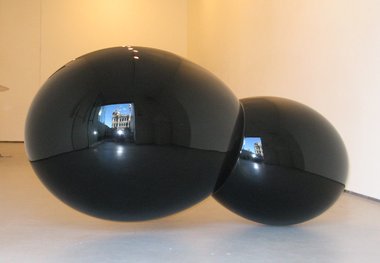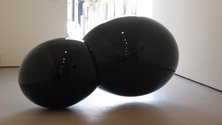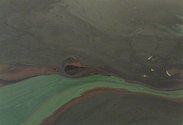David Cross – 28 February, 2011
With their heavily laboured and gestural surfaces, 70s colour scheme and inert matte finish, the paintings set up an especially peculiar dialogue with the objects. They are almost antagonistic to their industrially formed slickness.
Wellington
Seung Yul Oh
o0O0o2
February 2011 - 26 February 2011
There is a fundamental perversity that underpins Seung Yul Oh’s blemish-free sculptures at Bartley and Company. His hyper-refined gloss finishes on abstract forms are on the one hand immensely alluring but the act of simply looking at them does not quite satiate your needs. You want to touch them or, to be more precise, stroke them, to feel a surface that suggests it is without resistance. The ‘feeling is believing’ ethos of running fingers along pristine car duco is only accentuated by the objects shape and size. The two sculptures both entitled o0O0o are plumply anthropomorphic but not quite human scale, suggestive of oversized dolls or cartoon sci-fi creatures. Each object balances precariously in the gallery space and children plus no doubt some adults, will want to hug them. But cue perversity, you cannot. The slightly saccharine urge to confer affection on an inanimate object is kept in check by the ‘no-hugging the art’ policy.
While greasy fingerprints have always been the bete-noir of minimalism, one gets the sense that this is not the only reason the artist feels the need to establish a respectful distance. He wants the objects to be hyper-real, immaculate and somehow not of this world and to achieve this elusive quality they need to assert a defiant presence in their own space. In this sense they are avowedly retro-modernist objects that link the anthro and mechano-morphic to squeeze a bit more juice out of the abstract sculptural idiom. As with all good neo-modernist sculpture, the objects create the illusion of denying weight and floating miraculously in space employing that conventional, if still compelling, sleight of hand that is the illusionistically engineered object. By concealing the discrepancy in weight from the bottom of the object to the top, the forms capture that pregnant sense of impending movement with a convincing economy of means.
As much as the artist has absorbed the thinking of Brancusi and co, the two sculptures sit in an interesting relationship between past and present. While hermetic and clearly of the less is more school, they are also twee and slightly kitsch in a post-Koonsian/Murakami kind of way. They draw on the futuristic obsession of twentieth century culture but more in the popular vein of Astroboy or the girl robot in Wall-E than the vanguard elitism of Boccioni or Moholy-Nagy. They are also less self-obsessed than most modern forms owing to the uber-reflective black surfaces that bring into play that classic minimalist device of site-responsiveness. This reflectivity gives the sculptures a screen-like quality projecting back to us the lines and colours of the gallery, passing traffic and our own bodies sliding across each form in real time.
Running against the grain of the pair of sculptures are two paintings both entitled Rockpool. Unlike the three dimensional forms, these paintings are anything but a minimal/pop hybrid and speak instead of a sort of strange psychedelic landscape. With their heavily laboured and gestural surfaces, 70s colour scheme and inert matte finish, they set up an especially peculiar dialogue with the objects. While similarly at the cusp of figuration and abstraction and suggestive of planetary surfaces, they are almost antagonistic to the objects’ industrially formed slickness.
This conjunction is difficult to accommodate, except to render the aesthetic languages of both modes vaguely provisional and ultimately subservient to a bigger conceptual picture. What this picture is exactly seems difficult to recover amid the myriad references, so as a result there is an almost galling confidence in play where the artist feels he can pull off such a discordant alignment without discrediting the integrity of each mode. Something about this attitude of aesthetic relativity is impressive - in a boisterous kind of way - but the turgid, largely one-dimensional quality of the paintings leaves the sculptural forms in a more nuanced and compelling space of engagement.
David Cross






 Advertising in this column
Advertising in this column Two Rooms presents a program of residencies and projects
Two Rooms presents a program of residencies and projects



This Discussion has 0 comments.
Comment
Participate
Register to Participate.
Sign in
Sign in to an existing account.